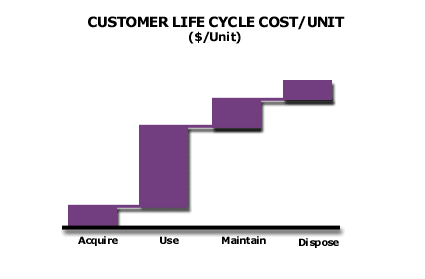BASIC STRATEGY GUIDE: STEP 16
Activity Two (Steps 13-18):
Develop new products and services to gain share with Core customer segments.
Step 16: Estimate the customer’s life cycle cost with the product

What:
Calculate the full costs the customer incurs over the life cycle of the product. The Company would then convert these costs into a cost per unit of product. In this way, the Company can assess the customer’s life cycle cost per unit against the price per unit the customer pays the Company. The analysis should cover the cost the customer incurs from the time he decides he needs the product until he finally disposes of it:
-
The Final or End Use customer incurs four major types of cost over a product’s life: Acquire, Use, Maintain, and Dispose. These cost categories are the same whether the Final customer purchases from an Intermediary or from the producer of the product.
-
A customer of the Company who is an Intermediary customer, a channel of distribution, incurs four similar types of cost during its life cycle with the product: Obtain, Sell, Guarantee, and Return.
The “customers” of particular interest in this step are the largest core customers available to the Company. The Company can augment this understanding of the costs of these larger core customers by doing variations of this analysis for the other core customer size segments that the Company would like to serve.
Why:
The objective for the vast majority of product and service innovations is to reduce customer costs. Accordingly, the Company needs a good understanding of the customer’s life cycle cost per unit of product in order to quantify and prioritize potential innovations.
What to Watch For:
-
The price of the product is usually included in the Use cost for the Final customer and in the Obtain cost for the Intermediary customer.
-
The services that accompany the company’s product often reduce the Final customer’s Acquire, Maintain or Dispose costs, or the Intermediary customer’s Sell, Guarantee or Return costs.
Action:
Use the conclusions here as the basis to develop a potential set of product and service innovations to win an increased share of Core customer business.
-
Audio Tip #79: How Much Must My Product Reduce the Customer’s Costs?
-
Self Test #16: Estimating the Core Customer’s Life Cycle Costs Per Unit
-
Worksheet #16: Estimating the Core Customer’s Life Cycle Costs Per Unit
More Information on the “Two Customers” on the Advanced Site >>
More Information on Customer Cost Systems on the Advanced Site >>
For helpful context on this step:
Videos:
-
Video #69: Overview of Products and Services Part 1: How to Look
-
Video #30: The Customer Cost System for a Manufactured Product
Symptoms and Implications:
